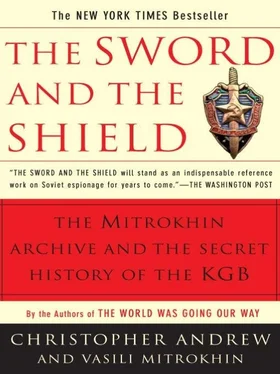The aggressive global grand strategy against the Main Adversary, devised in the summer of 1961 by Shelepin and approved by Khrushchev and the Central Committee, envisaged the use of national liberation movements both in operations against the United States and its allies and in promoting “armed uprisings against reactionary pro-Western governments.” At the top of the list of national liberation movements cultivated by the KGB was the newly founded Sandinista National Liberation Front (FSLN) in Nicaragua, which was dedicated to following the example of the Cuban revolution and overthrowing the brutal pro-American dictatorship of the Somoza dynasty. 40The FSLN leader, Carlos Fonseca Amador, codenamed GIDROLOG (“Hydrologist”), was described by the Centre as “a trusted agent.” 41Sandinista guerrillas formed the basis for a KGB sabotage and intelligence group established in 1966 on the Mexican US border with support bases in the area of Ciudad Juarez, Tijuana and Ensenada. Its leader, Manuel Ramón de Jesus Andara y Ubeda (codenamed PRIM), traveled to Moscow for training in Line F operations. Among the chief sabotage targets across the US border were military bases, missile sites, radar installations and the oil pipeline (codenamed START) which ran from El Paso in Texas to Costa Mesa, California. Three sites on the American coast were selected for DRG landings, together with large-capacity dead-drops in which to store mines, explosive, detonators and other sabotage materials. A support group codenamed SATURN was given the task of using the movements of migrant workers ( braceros ) to conceal the transfer of agents and munitions across the border. SATURN’s headquarters was a hotel belonging to a Russian-born agent, codenamed VLADELETS (“Proprietor”), in Ensenada fifty miles from the US border in the Baja California. VLADELET’s two sons, both born in Mexico but assessed by the KGB as “Russian patriots,” owned a gas station which was selected as a hiding place for DRGs and their equipment as well as a base from which to conduct sabotage in the United States. 42
Canada in the north, like Mexico in the south, was intended by the Thirteenth Department (reorganized in 1965 as Department V) as a base for cross-border operations by DRGs against the Main Adversary. In 1967 a number of frontier crossings were reconnoitred: among them areas near the Lake of the Woods and International Falls in Minnesota, and in the region of the Glacier National Park in Montana. The KGB believed that one of its targets in Montana, the Flathead dam, generated “the largest power supply system in the world.” Department V identified a point (codenamed DORIS) on the South Fork river about three kilometers below the dam, where it could bring down a series of pylons on a steep mountain slope which would take a lengthy period to repair. It also planned a probably simultaneous operation in which DRG commandos would descend on the Hungry Horse dam at night, take control of it for a few hours and sabotage its sluices.
The state with the largest number of targets, however, was almost certainly New York, where DRG’s based along the Delaware river, in the Big Spring Park near Harrisburg, Pennsylvania, and at other locations planned to disrupt the power supply of the entire state before taking refuge in the Appalachian mountains. In examining the target files of the Thirteenth Department and Department V, Mitrokhin was invariably struck by the thoroughness with which each target had been reconnoitred. The file on the port of New York (target GRANIT), for example, included details of ships’ berths, warehouses, communications systems, port personnel and security procedures. As always, the port’s most vulnerable points were carefully marked. 43
As well as being a base of KGB “special tasks” against the United States, Canada was also an important target in its own right. Operation KEDR (“Cedar”), begun by the Ottawa residency in 1959, took twelve years to complete an immensely detailed reconnaissance of oil refineries and oil and gas pipelines across Canada from British Columbia to Montreal. Each target was photographed from several angles and its vulnerable points identified. The most suitable approach roads for sabotage operations, together with the best getaway routes, were carefully plotted on small-scale maps. 44
Line F operations in north America were part of a much larger strategy. In the event of war with NATO, Moscow planned a massive campaign of sabotage and disruption behind enemy lines. But sabotage on a more modest scale was also envisaged in crises (not precisely defined in files seen by Mitrokhin) which stopped short of war. Within Europe, residencies in NATO countries and some neutral states (notably Austria, Sweden and Switzerland) were all expected to make detailed plans for the sabotage of four to six major targets a year. 45In 1964-6, for example, Line F in West Germany planned “special actions” against the Wilhelmshaven-Wesseling oil pipeline; fuel and lubricant depots in Wilhelmshaven and Unterpfaffenhoven; the main electrical substations in Brauweiler and Rommerskirchen and in the hamlet of Feinau; the NATO military transit base in the harbor of Bremerhaven; the FRG government war bunker; the Howaldswerft shipbuilding docks at Kiel and the Weser A G in Bremen; and the main US army arms depot at Misau. On instructions from the Centre, the Bonn residency purchased uniforms and work clothes, used by Bundeswehr soldiers, railway personnel, forestry workers, gamekeepers and roadworkers, to be worn as disguise by DRG saboteurs, for whom landing sites were selected in the Black Forest and Bavaria. Arms and radio equipment for use in the sabotage missions were hidden in dead-drops near the targets. 46The standard DRG arms package, packed in a container designed for long-term storage, consisted of: equipment for blowing up railway track; one “Cherepakha” (tortoise) mine with 3 additional explosive charges; 4 “Ugolok” devices (purpose not specified in Mitrokhin’s notes); explosives designed to destroy the main supports of high-voltage power transmission pylons; 3 6-meterlong detonator fuses; and 2 Karandash (“pencil”) detonators with a two-hour delay. 47Each arms cache might include more than one container. Radio transmitters and receivers were usually concealed in separate caches, sometimes with local currency for use by the DRGs. In August 1965, for example, 10,000 deutschmarks were placed in the TREZUBETS cache near Bonn; several attempts to locate it a decade later all failed and the money was written off. 48
Italy was divided by the Centre into four main zones of operations, each with two landing sites and bases for DRGs: the foothills of the Alps (with sites near Venice and in the Milan-Turin region), the remainder of the north (with sites in the Arno valley and the Livorno-Pisa-Florence area), the center and the south. Each site for parachute landings by DRGs had to be a level area without buildings of approximately 1 by 1.5-2 kilometers. In each zone, a large arms cache was hidden in land or property belonging to an experienced agent; radio equipment and money were hidden in dead-drops. The Rome residency was instructed to buy samples of the uniforms worn by the armed services, police, carabinieri, railway and forestry workers, as well as typical clothing of the local inhabitants near the landing sites. For the use of DRGs in the most northerly region, the residency was asked to acquire badges from Alpine units of the armed services. Line F prepared files on power-transmission lines, oil pipelines, bridges, tunnels and military installations within a 120-kilometer radius of each landing site. A four-volume file was prepared on former members of the Italian wartime resistance who, it was hoped, would assist in sabotage missions. 49
Similar sabotage plans were made for all Department V’s target countries. Each DRG landing site was known as a DOROZHKA (“runway”), each of its bases as a ULEY (“beehive”). 50Among the most sinister remnants of the Cold War, still scattered around north America, most of western and central Europe, Israel, Turkey, Japan and some other parts of the world, are the caches of KGB arms and radio equipment intended for use by the DRGs. Mitrokhin’s notes include precise details of their locations in a number of countries. Some are booby-trapped with MOLNIYA (“lightning”) explosive devices designed to destroy their contents if the caches are opened, and are highly dangerous. 51Indeed, one or more of the caches may already have caused explosions mistakenly attributed to other causes.
Читать дальше











